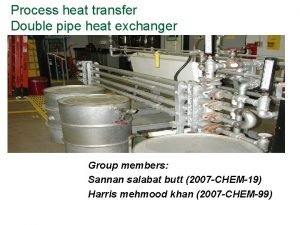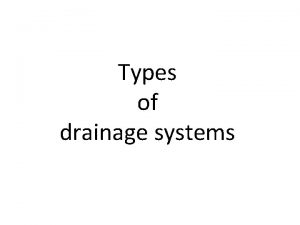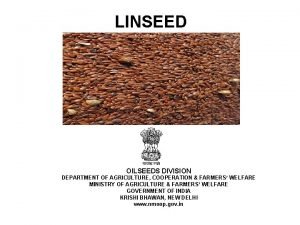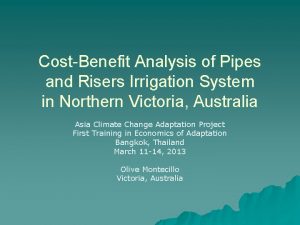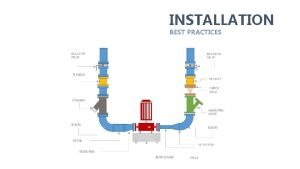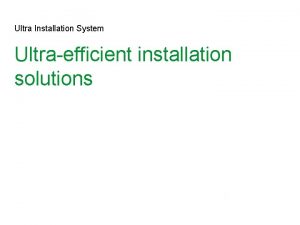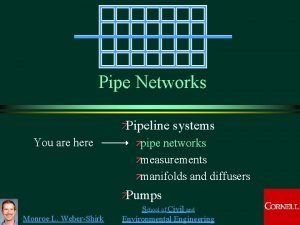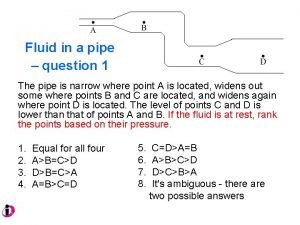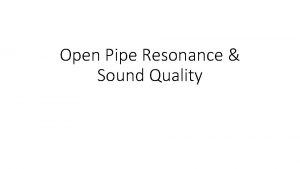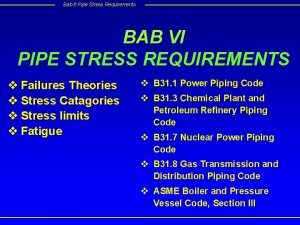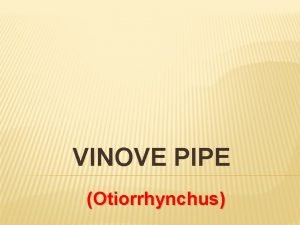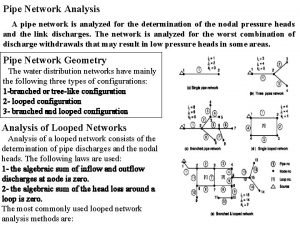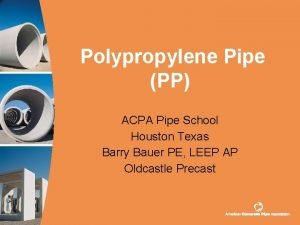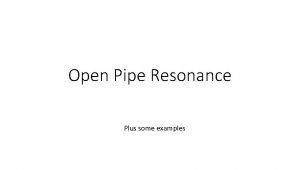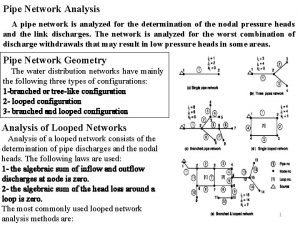Pipe Systems Installation methods pipe varieties in District


























- Slides: 26

Pipe Systems Installation methods & pipe varieties in District Heating

Low. TEMP training package - OVERVIEW Introduction Financial Aspects Intro Climate Protection Policy and Goals Life cycle costs of LTDH projects Intro Energy Supply Systems and LTDH Economic efficiency and funding gaps Energy Supply Systems in Baltic Sea Region Contracting and payment models Energy Strategies and Pilot Projects Methodology of Development of Energy Strategies Business models and innovative funding structures Technical Aspects Power-2 -Heat and Power-2 -X Thermal, Solar Ice and PCM Storages Heat Pump Systems LT and Floor heating Tap water production Ventilation Systems Best Practice Pilot Energy Strategies – Aims and Conditions Pipe Systems Best Practice I Pilot Energy Strategy – Examples Combined heat and power (CHP) Best Practice II Pilot Testing Measures Large Scale Solar Thermal CO 2 emission calculation Waste & Surplus Heat LCA calculation Large Scale Heat Pumps 2

Content Introduction to this module General overview of Pipe systems & DH-infrastructure • Functional classification of DH-pipe systems • Classification of DH-systems by grid levels Installation methods & pipe designs Heat transport medium Simplified EXAMPLE of Network planning & heat estimation 3

Introduction to this module Basic facts about DH pipe systems water temperatures of DH-systems range usually from 80°C to 120 °C of supply and 30 to 70 °C of return water (temperature levels depend on the used system and other conditions like weather, etc. ) Low. TEMP-network temperature levels range up to 80 °C supply temperature Heat losses of pipe systems range from approx. 5 to 10 % in proportion to the produced heat Type of pipes that are mostly used in DH- networks: plastic jacket pipes (PJP); Steel jacket pipes (SJP); FLEX-pipes European wide DH-customers can be estimated on approx. 60 million citizens with an increasing number in future! (Euro. Heat & Power) 4 Source: pixabay

Introduction to this module Source: ICAX 5

Introduction to this module Heat generating technologies within DH-systems are able to integrate different heat sources within one heat network DH-systems could therefore help to integrate more and more renewables within the heating sector Possible heat sources: • • • 6 Heating plants Thermal power stations Combined heat and power units (CHP) Waste heat integration from industrial processes Heat utilization from waste incineration Solid & liquid biomass Large heat pumps Geothermal heating units Solar thermal systems, etc. Source: pixabay

General overview of pipe systems & DH-infrastructure Functional classification of DH-pipe systems Piping systems of DH-networks can be roughly classified in following categories/terms: • Transport pipes • Distribution pipes • Connecting pipes (to consumer substation) EXAMPLE: waste heat utilization with a DH-system & network structure 7 Source: AGFW

General overview of pipe systems & DH-infrastructure Classification of DH-pipe systems by grid levels: Dual-pipe system 4 -pipe system 3 -pipe system Source: AGFW closed district heating grid Source: AGFW 1 st flow line used for heating purposes 2 nd flow line (�� = const. ) used for water and air heating High installation costs More complex operation 8 Source: AGFW Two overlapping dual-pipe systems management of specific heat demands and supply High installation costs Usage in special cases only

General overview of pipe systems & DH-infrastructure DH-network structure/design: Radial network Ring network shortest length in comparison to other network designs usually used in small heat networks with one central heat source 9 Source: AGFW Flow and return line are dimensioned symmetrically Mesh network circular connected main distribution pipes facilitates the integration of other heat sources During maintenance, it is possible to ensure partial supply Combinations of radial and ring networks are possible Common version of the ring network distribution pipes and heating units are linked together in operation Ring with cross connections

General overview about Pipe systems & DH-infrastructure The size of the system can be characterized by the following parameters: Length of the piping system (trench length) [m, km] Number of substations Number of connected consumers Amount of investment costs [M€] Complexity (e. g. number of heat generators, connection points, grid levels) Distributed energy (sold heat) [MWh, GWh, TWh] Installed heat generation capacity [MW, GW] Spatial coverage of the district [km²] (Source: Upgrade-DH, 2019) 10

Installation methods & pipe designs Aboveground lines Underground lines Source: all AGFW 11

Installation methods & pipe designs Installation methods biggest part of DH-piping systems is usually installed underground sometimes huge aboveground transport lines can be found next to train tracks, bridges and very seldom also overland For underground lines two main installation methods are used: • Channel or in-duct laying methods • Trench laying methods Examples of in-duct laying methods & trench laying methods (Source: all AGFW) 12

Installation methods & pipe designs Channel or in-duct laying methods reliable protection against mechanical damages support against unwanted moisture but very cost intensive method is only being applied in very special cases nowadays shape of the channel can vary Semi-circular hooded channel, rectangular hooded channel and double angle channel are most common systems for in-duct laid pipelines (Source: AGFW) 13

Installation methods & pipe designs Cross section of a hooded DH-channel Source: AGFW 14

Installation methods & pipe designs Summary of channel or in-duct laying methods Advantages Disadvantages Sturdiness and safety against external influences (e. g. mechanical, ground and surface water) Expensive installation High service life expectancy (70 years) Time-consuming construction Shafts allow inspection lot of space is needed for construction Point of damage can be localized sufficiently enough Good ventilation from shaft to shaft Source: AGFW 15 Water-resistance against (ground and surface) water is difficult

Installation methods & pipe designs The trench laying methods are much more common than the construction of hooded-systems important that the pipes are implemented in frost-free depths approximately below one meter trench depth for Central Europe risk of frost damaging the pipes is normally very low due to heat losses installation base or bedding layers are necessary to avoid pipe damages drainage of the trench must be ensured top laying sand bed is also called the friction layer that must provide sufficient and stable resistance to axial pipe movement (implementation of adhesion zones necessary) 16 Installation of plastic-jacket pipes with the trench laying method (Source: Adobe. Stock Image)

Installation methods & pipe designs The trench laying method Installation of plastic-jacket pipes with the trench laying method (Source: Adobe. Stock Image) Cross-section through a DH-trench laying system (Source: AGFW) 17 Installation of plastic-jacket pipes with the trench laying method (Source: Adobe. Stock Image)

Installation methods & pipe designs Pipe designs Steel jacket pipe-systems Sleeve PE-Cover pipe • Reliable protection against external stresses – versatile applications • Thermal insulation per fiber insulation material and/or vacuum • Medium temperatures up to 400°C Steel pipe Weld connection PU foam Plastic jacket pipe-systems • • Minimum lifetime > 30 years Water- and damage-proof against external stresses Good thermal insulation Constant operation temp. ≤ 120°C Annular gap Heat insulation layer Steel pipe Heat insulation layer Both operate with steel and plastic medium pipes Vacuum or nitrogen over pressure Jacket Pipe 18 Passive corrosion protection No laminar fusion between inner pipe and jacket pipe Source: Fastabend/ Rhein. Energie AG

Installation methods & pipe designs Pipe designs basic structure of commonly used piping technologies - two concentrically placed pipes that are separated by an insulating layer outside casing from plastic or steel functions as protection against moisture and corrosion of the inner medium pipe usually are equipped with additional wires inside the insulation, which could help to detect leakages One-pipe layout and two-pipe layout (Source: AGFW) 19 Source: D. Rutz

Installation methods & pipe designs Overview of different PJPs PJP pipe with a steel medium pipe (Source: D. Rutz) 20 Varieties of flexible PJPs – so called PEX-pipes - with a plastic medium pipe (Source: Logstor / Uponor)

One example of sleeve connections 1 Medium pipe 2 Weld connection 3 Factory produced PU foam 4 On-site produced PU foam 5 PE-jacket pipe 6 PE-X-shrink sleeve 7 Shrink tape with hot melt glue 21

Heat transport medium DH piping system is also influenced by the quality of the heat transport medium which is described in AGFW FW 510 (2018) The criteria for the assessment of DH water are: Electrical conductivity at 25°C impact on the operation lifetime of the piping network Appearance influences the rate of corrosion for the steel made medium pipe Oxygen Bad quality could cause deposits in the pipelines or valves Iron p. H value at 25°C Sum of alkane earth (hardness) Copper Sulphide For the application of water in DH two operating modes can be classified: saline circulation water and low-salt circulation water 22 Sulphate

EXAMPLE: simplified case of network planning Example: A city plans to build a new residential area and the nearby cogeneration plant has free capacities to supply the new district. A network for district heating has to be planned between the cogeneration plant and the residential area (blue). CHP Development and heat planing for a new district Source: Dipl. -Ing. Fastabend - Rhein. Energie 23

EXAMPLE: simplified case of network planning 1 st Step: Determine heat demand (following DIN EN 12831) Usually the city or the investor have information about the heat demand Gross floor area (GFA) allows a good estimation of the heat demand Experienced heat demand values Single-family house Terrace house 8 -10 k. W (without hot water supply) 15 -18 k. W (with hot water supply) Freestanding 15 -20 k. W (without hot water supply) 18 -25 k. W (with hot water supply) 24 Specific heat demand House development 40 -60 W/m 2 GFA Office use 60 -80 W/m 2 GFA Commercial area 60 -80 W/m 2 GFA Special use ≤ 100 W/m 2 GFA

EXAMPLE: simplified case of network planning Calculation of heat demand: 3. 720 k. W 2 nd Step: Determine further parameters • Network operation • Pressure loss 3 rd Step: Define first lines 4 th Step: Dimension pipes Source: Dipl. -Ing. Fastabend - Rhein. Energie 25

Contact AGFW-Project Gmb. H Project company for rationalisation, information & standardisation Georg Bosak Department of urban development Stresemannallee 30 60596 Frankfurt am Main Germany E-mail: info@agfw. de Tel: +49 69 6304 - 247 www. agfw. de 26
 Double pipe heat exchanger formula
Double pipe heat exchanger formula Single pipe system
Single pipe system Chapter 6 varieties of drama
Chapter 6 varieties of drama Bell's seven criteria for language
Bell's seven criteria for language Territorial varieties of english pronunciation
Territorial varieties of english pronunciation Ismail varieties store
Ismail varieties store Market forms of lobster
Market forms of lobster Rice photos
Rice photos What is standard variety of language
What is standard variety of language Drosera capensis varieties
Drosera capensis varieties Varieties of drama
Varieties of drama Linguistic varieties and multilingual nations
Linguistic varieties and multilingual nations Definition of language variety
Definition of language variety Varieties of culture
Varieties of culture A merchant mixes three varieties of wheat costing
A merchant mixes three varieties of wheat costing Types of suspension therapy in physiotherapy
Types of suspension therapy in physiotherapy Project termination
Project termination Which organism
Which organism What is language variation
What is language variation Indigenized varieties
Indigenized varieties Arka archana
Arka archana Exfac
Exfac Language
Language When apple growers talk about new varieties
When apple growers talk about new varieties Chapter 8 varieties of american nationalism
Chapter 8 varieties of american nationalism Metal coping fpd
Metal coping fpd Riser pipe irrigation
Riser pipe irrigation
